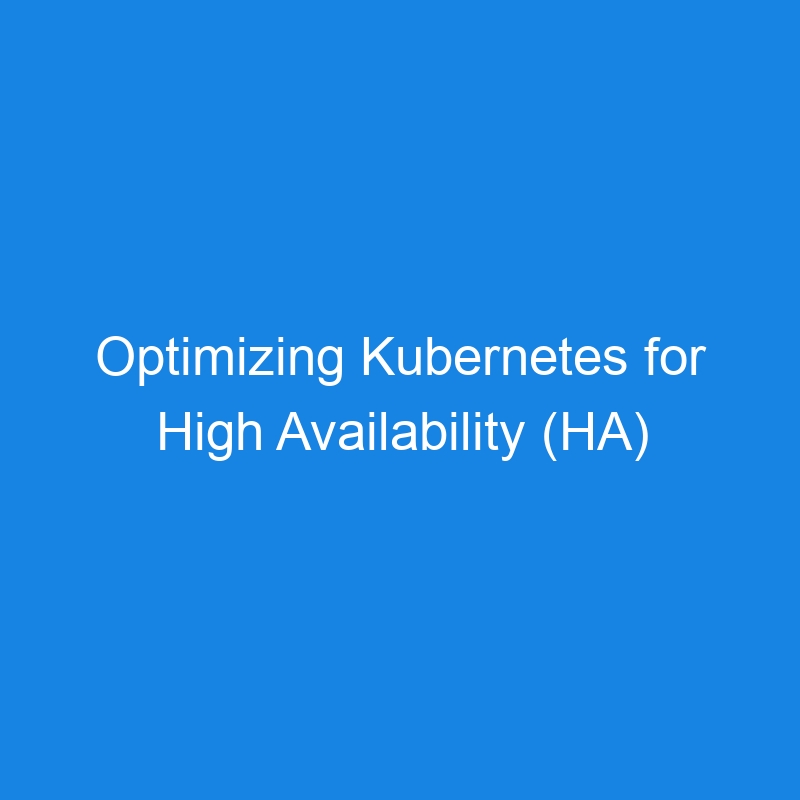Optimizing Kubernetes for High Availability (HA)
High Availability (HA) is a critical requirement for production Kubernetes clusters to ensure minimal downtime and resilience against failures. Optimizing Kubernetes for HA involves designing the architecture, configuring components, and implementing best practices to maximize the reliability and performance of your cluster.
Key Components of a High-Availability Kubernetes Cluster
-
Control Plane Resilience:
- The control plane manages the Kubernetes cluster and consists of components like the API Server, etcd, Scheduler, and Controller Manager.
- Redundancy and load balancing for control plane components are essential for HA.
-
Worker Node Reliability:
- Worker nodes host application workloads. Ensuring their availability through redundancy and proper health monitoring is critical.
-
Network Stability:
- Kubernetes relies heavily on networking. Configuring reliable and redundant networking ensures smooth communication between components.
-
Data Persistence:
- Kubernetes stores cluster state in etcd. Ensuring etcd availability and data integrity is key.
Steps to Optimize Kubernetes for High Availability
1. Redundant Control Plane Nodes
- Deploy multiple control plane nodes to avoid a single point of failure.
- Use an odd number of control plane nodes (e.g., 3 or 5) to enable leader election and maintain quorum for etcd.
2. Etcd High Availability
- Etcd stores all cluster state data. Configure it for HA by:
- Running an odd number of etcd instances (3 or 5) to maintain quorum.
- Using persistent storage for etcd data.
- Backing up etcd regularly to recover from data loss.
3. Load Balancing the API Server
- Deploy an external or internal load balancer to distribute traffic across multiple API servers.
- Example: Use tools like HAProxy, NGINX, or cloud provider load balancers.
# Example HAProxy Configuration
frontend kubernetes
bind *:6443
mode tcp
default_backend apiservers
backend apiservers
mode tcp
balance roundrobin
server api1 10.0.0.1:6443 check
server api2 10.0.0.2:6443 check
server api3 10.0.0.3:6443 check
4. Highly Available Worker Nodes
- Use multiple worker nodes in different zones or regions to distribute workloads.
- Leverage node pools to manage groups of nodes with specific configurations.
5. Deploy Highly Available Applications
- Use Kubernetes Deployments to ensure multiple replicas of your Pods are running.
- Distribute replicas across nodes using
topologySpreadConstraintsor Pod anti-affinity rules.
Example: Anti-affinity to distribute Pods.
affinity:
podAntiAffinity:
requiredDuringSchedulingIgnoredDuringExecution:
- labelSelector:
matchExpressions:
- key: app
operator: In
values:
- my-app
topologyKey: "kubernetes.io/hostname"
6. Networking Resilience
- Use redundant network interfaces and routes.
- Deploy CNI plugins like Calico, Weave Net, or Flannel configured for HA.
- Use multiple ingress controllers to avoid a single point of failure.
7. Persistent Storage HA
- Use cloud provider storage solutions (e.g., AWS EBS, GCP Persistent Disks) that offer replication and failover.
- Implement dynamic provisioning using Storage Classes.
- For on-premises setups, use distributed storage systems like Ceph, GlusterFS, or OpenEBS.
8. Monitoring and Alerts
- Deploy tools like Prometheus and Grafana to monitor cluster health.
- Set up alerts for critical metrics like CPU usage, memory pressure, and Pod evictions.
9. Disaster Recovery Planning
- Perform regular backups of etcd and application data.
- Test restoration processes periodically to ensure recovery reliability.
- Use tools like Velero for Kubernetes backup and restore.
Best Practices for High Availability in Kubernetes
-
Leverage Multiple Zones/Regions:
- Spread control plane nodes and worker nodes across availability zones or regions.
- Use cloud provider features like regional Kubernetes clusters.
-
Automate Failover:
- Enable automatic rescheduling of Pods using node affinity and taint tolerations.
- Configure Horizontal Pod Autoscalers (HPA) for application scaling.
-
Secure the Cluster:
- Enable Role-Based Access Control (RBAC) to prevent unauthorized access.
- Use network policies to control traffic between Pods.
-
Regular Updates and Patching:
- Keep Kubernetes and node components updated to the latest stable versions.
- Use managed Kubernetes services (e.g., GKE, EKS, AKS) for easier updates.
-
Test HA Configurations:
- Simulate failures (e.g., shutting down a control plane node) to test the resilience of the cluster.
Sample High-Availability Architecture
-
Control Plane:
- 3 API Servers (HAProxy load-balanced).
- 3 etcd nodes with persistent storage.
-
Worker Nodes:
- 5 Worker Nodes spread across 3 availability zones.
-
Networking:
- Calico CNI plugin with redundant network paths.
-
Ingress:
- 2 NGINX Ingress Controllers deployed with a load balancer.
Conclusion
High Availability in Kubernetes ensures that your cluster can withstand failures and maintain service continuity. By deploying redundant control planes, configuring HA for etcd, leveraging load balancers, and ensuring reliable networking and storage, you can optimize Kubernetes for robust production environments.
